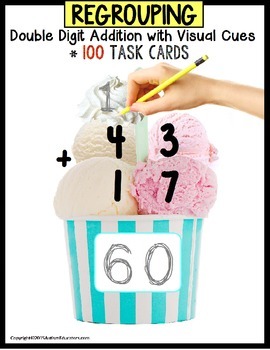Double Digit Addition TASK CARDS with REGROUPING for VISUAL LEARNERS
- PDF
What educators are saying
Also included in
- This is a custom bundle of academic resources aligned with state learning standards. These are academic tasks aligned with state standards in the areas of reading, writing, and math, as well as fine motor and life skills. This Custom Bundle was built to create a stress-free year of follow-up lessoPrice $62.00Original Price $78.50Save $16.50
Description
Double Digit Addition with REGROUPING for VISUAL LEARNERS
Learning 2-digit addition can be a challenging concept for some of our students, both the General Ed and Special Needs population. By using fun visuals to help your students understand regrouping and where to “carry” the number, will help them to remember and retain the concept as they “regroup on the scoop”! Watch as they work independently on this “sweet” activity! Great for your math center, independent work task system, small group, or one-on-one instruction. INCLUDES over 100 “delicious” ice cream sundae learning Task Cards!
*IEP Goal for our special needs students:
Given a visual cue to indicate placement of the number to carry over when solving a 2-digit addition problem, STUDENT will independently solve the problem by writing the correct sum, with 80% accuracy, in 4 out of 5 opportunities, by MONTH, YEAR.
Thank you for your continued support.
Debbie
Find us on PINTEREST by clicking here!
Find us on FACEBOOK by clicking here!
Find us on INSTAGRAM by clicking here!
Terms
Copyright © AutismEducators.com. All rights reserved by author. This product is to be used by the original downloader only. Copying for more than one teacher, classroom, department, school, or school system is prohibited. This product may not be distributed or displayed digitally for public view. Failure to comply is a copyright infringement and a violation of the Digital Millennium Copyright Act (DMCA). Clipart and elements found in this PDF are copyrighted and cannot be extracted and used outside of this file without permission or license. Intended for classroom and personal use ONLY. See product file for clip art credits.






